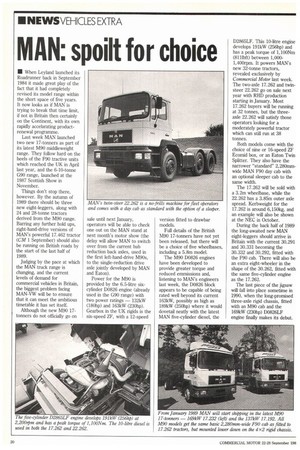AN: spoilt for choice
Page 14

If you've noticed an error in this article please click here to report it so we can fix it.
• When Leyland launched its Roadrunner back in September 1984 it made great play of the fact that it had completely revised its model range within the short space of five years. It now looks as if MAN is trying to break that time limit, if not in Britain then certainly on the Continent, with its own rapidly accelarating productrenewal programme.
Last week MAN launched two new 17-tonners as part of its latest M90 middleweight range. They follow hard on the heels of the F90 tractive units which reached the UK in April last year, and the 6-10-tonne G90 range, launched at the 1987 Scottish Show in November.
Things don't stop there, however. By the autumn of 1989 there should be three new eight-leggers, along with 24 and 28-tonne tractors derived from the M90 range. Barring any further hold ups, right-hand-drive versions of MAN's powerful 17.462 tractor (CM 1 September) should also be running on British roads by the start of the last half of 1989.
Judging by the pace at which the MAN truck range is changing, and the current levels of demand for commercial vehicles in Britain, the biggest problem facing MAN-VW will be to ensure that it can meet the ambitious timetable it has set itself.
Although the new M90 17tonners do not officially go on sale until next January, operators will be able to check one out on the MAN stand at next month's motor show (the delay will allow MAN to switch over from the current hub reduction back axles, used in the first left-hand-drive M90s, to the single-reduction drive axle jointly developed by MAN and Eaton).
Power for the M90 is provided by the 6.5-litre sixcylinder D0826 engine (already used in the G90 range) with two power ratings — 132kW (180hp) and 163kW (230hp). Gearbox in the UK rigids is the six-speed ZF, with a 12-speed version fitted to drawbar models.
Full details of the British M90 17-tonners have not yet been released, but there will be a choice of five wheelbases, including a 5.8m model.
The M90 D0826 engines have been developed to provide greater torque and reduced emmissions and, listening to MAN's engineers last week, the D0826 block appears to be capable of being rated well beyond its current 163kW, possibly as high as 189kW (250hp) where it would dovetail neatly with the latest MAN five-cylinder diesel, the D2865LF. This 10-litre engine develops 191kW (256hp) and has a peak torque of 1,100Nm (811Ibft) between 1,0001,40Orpm. It powers MAN's new 32-tonne tractors, revealed exclusively by Commercial Motor last week. The two-axle 17.262 and twinsteer 22.262 go on sale next year with RHD production starting in January. Most 17.262 buyers will be running at 32 tonnes, but the threeaxle 22.262 will satisfy those operators looking for a moderately powerful tractor which can still run at 38 tonnes.
Both models come with the choice of nine or 16-speed ZF Ecomid box, or an Eaton Twin Splitter. They also have the narrower "standard" 2,2801nmwide MAN F90 day cab with an optional sleeper cab to the same width.
The 17.262 will be sold with a 3.2m wheelbase, while the 22.262 has a 3.85m outer axle spread. Kerbweight for the 17.262 is around 6,150kg, and an example will also be shown at the NEC in October.
During the back half of 1989 the long-awaited new MAN eight-leggers should arrive in Britain with the current 30.291 and 30.331 becoming the 30.332 and 30.292, fitted with the F90 cab. There will also be an extra eight-wheeler in the shape of the 30.262, fitted with the same five-cylinder engine as the 17.262.
The last piece of the jigsaw will fall into place sometime in 1990, when the long-promised three-axle rigid chassis, fitted with an M90 cab and the 169kW (230hp) D0826LF engine finally makes its debut.










































































